|
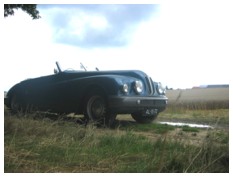 In
the summer of 2005, we made a Tour-de-France. Not on the bicycle however,
because
Teb
and me are of the lazy kind. Pedaling is nice, for half an hour or so,
provide there is no uphill stretch to be done. But after that, forget it.
On top of that, we had our little
Anna, who is quite jumpy
and thus not really the right character to attach to the backseat of your
bicycle. In
the summer of 2005, we made a Tour-de-France. Not on the bicycle however,
because
Teb
and me are of the lazy kind. Pedaling is nice, for half an hour or so,
provide there is no uphill stretch to be done. But after that, forget it.
On top of that, we had our little
Anna, who is quite jumpy
and thus not really the right character to attach to the backseat of your
bicycle.
Still, we wanted to do something special, however, since we do it almost
every year maybe it is not that special any more, but it still attracts
everybody's attention: traveling with the
Bristol.
Teb calls it a "rubber-neck-car" which it truly is, as many people turn
themselves 180 degrees while driving, to see if they can find a clue
towards the brand of this car, which they usually cannot. I shiver with
fear, seeing in my imagination the most horrible accidents, caused by the
beauty of this car. Up to now, luckily that did not happen.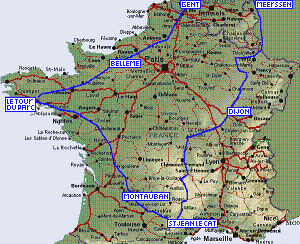 The car also has a good guardian angel.
The car also has a good guardian angel.
The route we drove can be seen on the map to the left. Of course, this car
does not drive all too fast, as it is 56 years old. Imagine somebody
driving 130 kilometers an hour 56 years ago, that would have been a
killer. Still, it easily reaches 100, but to keep the car in good shape,
we avoided the highway as much as possible and enjoyed the French
landscape.
We mostly took the roads that are colored yellow on the map, and sometimes
even white ones. That meant we did not meet many people on their way, as
most of the people nowadays take the fastest route towards their
destination. For us, the traveling itself was the holiday so we were not
in a hurry. And thus, we found the nicest and most quiet pick nick spots
to swallow our foie-gras and champagne lunches (56 years ago, it was still
allowed to drink a little and
 drive).
Sometimes, the car would stink of some old camembert, reaching the right
temperature for consumption. drive).
Sometimes, the car would stink of some old camembert, reaching the right
temperature for consumption.
Even
though the Bristol is a convertible, we drove most of the way with the
hood closed. Anna was forever jumping on the backseat (a 56 year old car
does not have any seatbelts) and we were afraid that she would jump out of
the car. Poor me had a very stiff neck after so many kilometers, but that
seems to be part of the fun. Anna loved the driving and even though she is
only just two years old, within a few days she could distinguish an
old-timer (Blistol!!!) from the usual cars (car!). That made her daddy
naturally very proud.
We started our trip close to Maastricht, where we visited friends. From
there, we drove straight to Dijon. Unfortunately, not that straight, since
there was work on the road and we had to make a big d-tour. The French
police, obviously aware of this d-tour and of the fact, that foreigners
obviously did not know their way around it, caught us, just
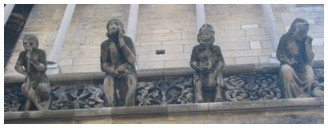 crossing a
white line. 90 Euro, mister! Since we had not that much money on us, we
were squashed between to motor police, guiding us to the next village with
a bank, which was at least 30 kilometers away. So we enjoyed more nice
scenery of France and the friendly (?) French police, showing their true
image to foreigners. That we managed to speak French did not help us, on
the contrary. crossing a
white line. 90 Euro, mister! Since we had not that much money on us, we
were squashed between to motor police, guiding us to the next village with
a bank, which was at least 30 kilometers away. So we enjoyed more nice
scenery of France and the friendly (?) French police, showing their true
image to foreigners. That we managed to speak French did not help us, on
the contrary.
As
a result of this event, we arrived in Dijon when the evening was no more
young. All restaurants were closed and we had to enjoy dinner with friends
in our own hotel.
We stayed one night, enjoying a nice croissant, cafe-au-lait and
patisserie and a walk through the city the next morning. Dijon is the
capital of the department of Cote-d'Or and the region
Burgundy. It is a very
nice old city, apparently dating back from the Roman times when it was
called Castrum Divionense. It has many
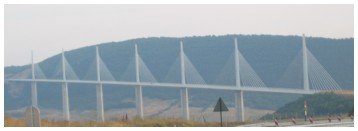 cathedrals and squares dating from
long ago and a great atmosphere. And don't forget the food that originates
from Dijon: the crème the cassis and the mustard, it is so strong
that it make tears come into your eyes! cathedrals and squares dating from
long ago and a great atmosphere. And don't forget the food that originates
from Dijon: the crème the cassis and the mustard, it is so strong
that it make tears come into your eyes!
From there, we went southwards
and crossed the Millau Viaduct, at this moment the tallest vehicular
bridge in the world. For two years, we witnessed how the enormous pillars
were built, and this year we could use it at last, which saved us a lot of
time and offered
us a great view. It is a real "golden gate of France", at least if you
look at the investment they must have made. It was build by architect Sir
Norman Foster, apparently a famous man. You must be if you are able to
create a gigantic object like this! It goes across the valley of the river Tarn and
stands on pillars of between 75 and 235 high. The highest point measures
341 meter from the ground, which makes it taller than the Eiffel tower and
almost as tall as the Empire State Building.
From there onwards we drove through the beautiful fields, through tiny
little villages, until we reached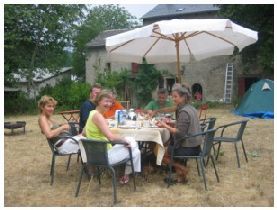 "St
Pierre les Cats", where our friends own
a house. Don't bother to look it up on any map, it is not there. It exists
of 4 houses, a church and a graveyard, and some cows. We even almost
missed it. "St
Pierre les Cats", where our friends own
a house. Don't bother to look it up on any map, it is not there. It exists
of 4 houses, a church and a graveyard, and some cows. We even almost
missed it.
We stayed two days. No cultural things we had to see there,
there is only nature, so just sit and relax.
On the way up, we passed through the city of Albi.
Albi is the capital of the department of Tarn and the river Tarn, the same
river spanned by the large viaduct, goes straight through the heart
 of the
city. This city was also know in the Roman times, by the name of Albiga.
Apparently the Romans
were very fond of France, possibly it was the wine that lured them in.
That is probably why Italy is now a very important wine country. Very
beautiful are the Saint Cecile Basilica and the Pont Vieux, which you can
see on the picture. More than one thousand years old and still alive with
traffic. Henri de
Toulouse Lautrec was born in the city, and there was an exhibition of his
work going on. of the
city. This city was also know in the Roman times, by the name of Albiga.
Apparently the Romans
were very fond of France, possibly it was the wine that lured them in.
That is probably why Italy is now a very important wine country. Very
beautiful are the Saint Cecile Basilica and the Pont Vieux, which you can
see on the picture. More than one thousand years old and still alive with
traffic. Henri de
Toulouse Lautrec was born in the city, and there was an exhibition of his
work going on. |
|
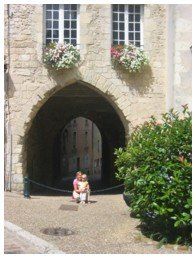 After
Albi we went on to Montauban, which is the capital of department Tarn-et-Garonne.
It is in the middle of a tourist area and this was the only area were we
ended up in a traffic jam. Montauban dates back from the twelfth century.
Apparently, in the 14th century it was ravaged by the Albigensians from
Albi. After that it was ceded by the English, given back, inhabited by
"normal" French for some time, and then again became an independent
Huguenot republic in the 16th century. After
Albi we went on to Montauban, which is the capital of department Tarn-et-Garonne.
It is in the middle of a tourist area and this was the only area were we
ended up in a traffic jam. Montauban dates back from the twelfth century.
Apparently, in the 14th century it was ravaged by the Albigensians from
Albi. After that it was ceded by the English, given back, inhabited by
"normal" French for some time, and then again became an independent
Huguenot republic in the 16th century.
Unfortunately, we did not have time to stay long as we were on our way to
"Le Tour du Parc" in Bretagne, a nice little village on the coast. There,
we got served the best fresh mussels we had ever tasted. Our host told us
over dinner how he had caught them himself, that same afternoon. I would
never have believed how much different the taste of a fresh mussel can be.
And he also spoilt us with oysters. Imagine, coming from Bangladesh, you
can hardly get a nicer treat!
As a result of quarrels between the cities Rennes and Nantes, the old
duchy of Brittany was split up into 2 regions. Nantes used to be the
capital and Rennes the seat of Parliament of Brittany. So now, part of
Brittany has become Bretagne and a small part falls under the
Pays-de-la-Loire. |
|
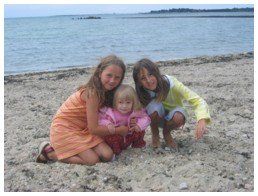 We
spent some time on the beach but the weather would not cooperate so we
just kept our coats on and made a walk. We made a trip with our host who
owns an old Bentley and attracted more gazes than ever. We
spent some time on the beach but the weather would not cooperate so we
just kept our coats on and made a walk. We made a trip with our host who
owns an old Bentley and attracted more gazes than ever.
After that, we went to Belleme. What struck the eye most in this village,
was a large golf course, but since Teb did not bring his clubs, we could
not enjoy it. It was a nice old, medium sized village. We enjoyed a
morning walk in the sun and stopped at a real estate agent, just to see
what was available. As usual, we avoided serious decisions and just talked
about how nice and cheap the houses were in this region. But we have not
come any further in deciding even in which country we want to live. I fear
that, if we are grey old pensionado's, we will still be traveling from
place to place, in a car that suits our age best, trying food and wines
everywhere and talking about how this place is even better than the last
one.
Our last stop was in Gent, but as this city already belongs to Belgium, it
will have to be covered in another page. Otherwise, the French might get
aspirations. |